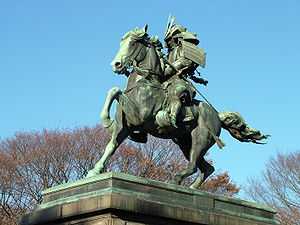Genkō War
| ||||||||||||||||||||||
The Genkō War (元弘の乱 Genkō no Ran) (1331–1333) also known as the Genkō Incident (元弘の変 Genkō no Hen) was a civil war in Japan which marked the fall of the Kamakura shogunate and end of the power of the Hōjō clan. The war thus preceded the Nanboku-chō period and the rise of the Ashikaga shogunate. Genkō is the name of the Japanese era corresponding to the period 1331-1334.
Throughout much of the Kamakura period, the shogunate was controlled by the Hōjō clan, whose members held the title of shikken (regent for the shogun), and passed it on within the clan. The Emperor was little more than a figurehead, holding no real administrative power.
In 1331, Emperor Go-Daigo tried to seize power and overthrow the shogunate. Along with an army of his loyal supporters, he attacked the shikken in the shogunal capital of Kamakura. He was defeated, however, as the result of the betrayal of a close associate named Yoshida Sadafusa (吉田定房). The Emperor hid the Sacred Treasures in a secluded castle in Kasagiyama (the modern town of Kasagi, Sōraku district, Kyoto Prefecture) and raised an army, but the castle fell to the shogunal army the following year. The shogunate enthroned Emperor Kōgon and exiled Go-Daigo to the island of Oki. This was the same place where Emperor Go-Toba had been exiled after the Jōkyū War of 1221.
The Emperor's son Prince Morinaga continued to fight, leading his father's army alongside Kusunoki Masashige.
Emperor Go-Daigo escaped Oki in 1333, two years after his exile, with the help of Nawa Nagatoshi (名和長年) and his family, raising an army at Funagami Mountain in Hōki Province (the modern town of Kotoura in Tōhaku District, Tottori Prefecture).
Meanwhile, Ashikaga Takauji, the chief general of the Hōjō family, turned against the Hōjō and fought for the Emperor in the hopes of being named shogun. Simultaneously, Nitta Yoshisada led his army on a campaign through Kōzuke and Musashi provinces culminating in the siege of Kamakura, setting fire to the city, and destroying the Kamakura shogunate.
The city aflame, the shogunate fell, and the power of the Hōjō with it. Emperor Go-Daigo returned to Kyoto, and claimed power in what came to be known as the Kemmu Restoration. This would only last a few years, though. In 1336 Ashikaga Takauji named himself Shogun and seized power from Go-Daigo, beginning the Nanboku-chō Wars and the Ashikaga shogunate.
References
Bibliography
- Frederic, Louis (2002). "Japan Encyclopedia." Cambridge, Massachusetts: Harvard University Press. ISBN 0-674-01753-6.
- Sansom, George (1963). "A history of Japan 1334-1615." Eight Printing (1993). Charles E. Tuttle Company, Tokyo, ISBN 4-8053-0375-1.
- Papinot, E. (1910). "Historical and Geographical Dictionary of Japan. 1972 Printing. Charles E. Tuttle Company, Tokyo, ISBN 0-8048-0996-8.
